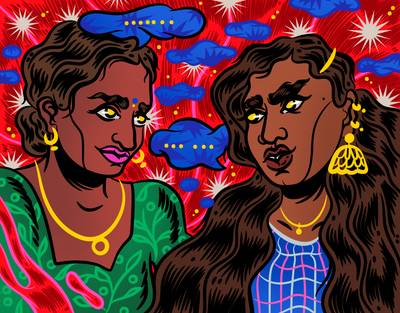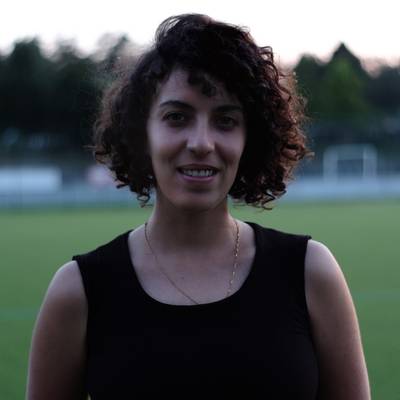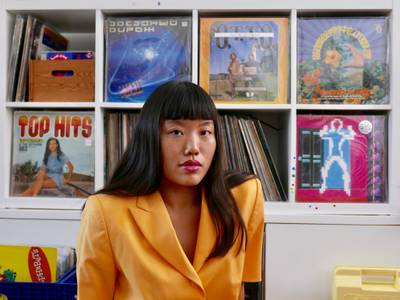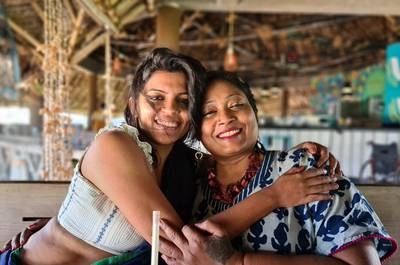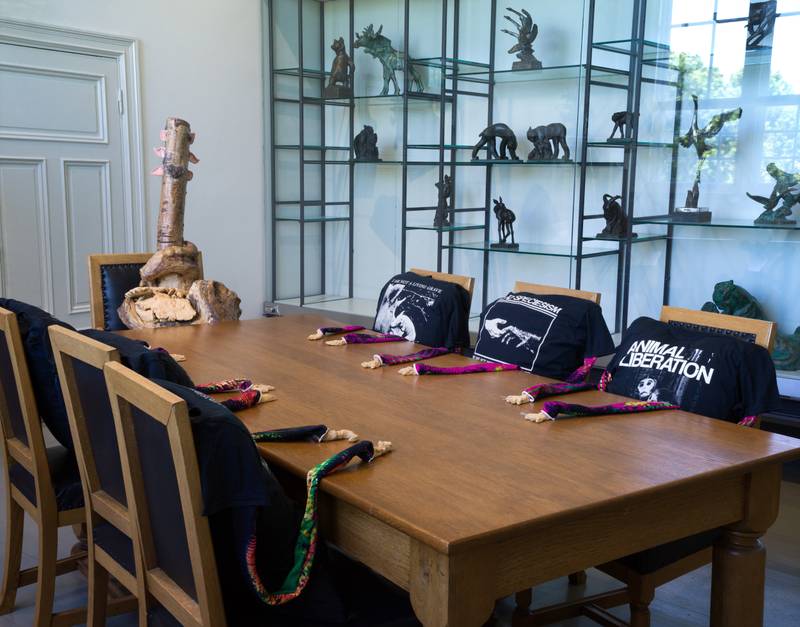

The singing burl presiding over the meeting at Primeval Soup, Turku Art Museum, 2021. Photo courtesy of Hertta Kiiski.
Sanna Ritvanen (b. 1989 in Sotkamo) is an artist, producer, cook, baker and creative mind working widely in the field of arts and culture. They are interested in collaborative and caring working methods in multidisciplinary groups and projects, trying to embrace the not knowing and failure with constant curiosity towards, well basically almost everything, from sourdough baking to urban planning.
A while ago I got this intriguing offer to interview the artist Hertta Kiiski. Even though I have been involved in the southern Finnish art scene for almost a decade now, I hadn’t met Hertta ever before. But it seemed like everyone else had.
I was remotely familiar with the artworks of hers but never saw any of them live. So I based my enthusiastic “yes” to the offer on information I had collected from discussions with my friends and colleagues. In those, Hertta appeared always as “the coolest”, “the sweetest” or “the most amazing” person.


Even Inari Minn, Portrait of Hertta Kiiski, 2021, pencil and digital
On Sunday 16.5.2021 at 11:00 sharp a tiny mint green car wheels behind the corner and stops in front of the Bridgettine Convent’s guest house in Turku, where we have agreed to meet. Hertta has been busy with arranging Avantgarden, a site-specific exhibition in Nuottaranta with her friends and fellow artists the past weeks. I instead have been spending an artful 24 hours in Turku, including visits to Hertta’s exhibition Primeval Soup in Turku Art Museum and Avantgarden on Satava island. After a year of not experiencing art almost at all, I feel nurtured, almost euphoric.
As soon as I sit in the front seat of the car the size of a herring tin, I understand where the opulent descriptions of Hertta are coming from. Her joy, warmth, and charisma tangle around me and fill the insides of the tiny Fiat.
After pointing out a crossroad where she crashed her car a decade ago and explaining that’s why she’s a bit scared of driving, Hertta asks me how I have thought to execute the interview. I tell her I could just record us talking. She bursts into laughter and warns me I might end up with a horrendous amount of material to edit - that she tends to talk a lot, and many times off-topic.
We arrive at Nuottaranta. I have promised to help Hertta and Ida, one of the nine artists of Avantgarden, to prepare the venue for the exhibition day. While lighting the fire to the fireplace to heat the chilly house, I press the rec button of the recorder and the unceasing, bubbly stream of talk for the next 90 minutes begins.
I think who am I to tell people I don’t know or I have never talked with, what and how they should do. What would I achieve with it?
HERTTA: I regret why I didn’t join the sea scouts when I had the opportunity but instead chose the regular scouts, I could have had the opportunity to learn to sail, but I am this kind of a hillbilly now.
SANNA: Oh, I am a scout too, the hillbilly one. But have you thought of learning to sail now in your adult days?
Well, I should focus on my commissioned work tomorrow, but instead I am going to a sailing course!
I am working on an installation for the Photo Ireland Festival. The work will be presented during July in different locations around Dublin; in a theatre where it will be designed to be suitable for kids, in a gallery and finally in the cityscape.
They (Hertta’s daughters and niece) would have had their first live performance there. We were also supposed to go there for a site visit, but then this pandemic came. Now we are doing videos, and hopefully going to perform later this year.
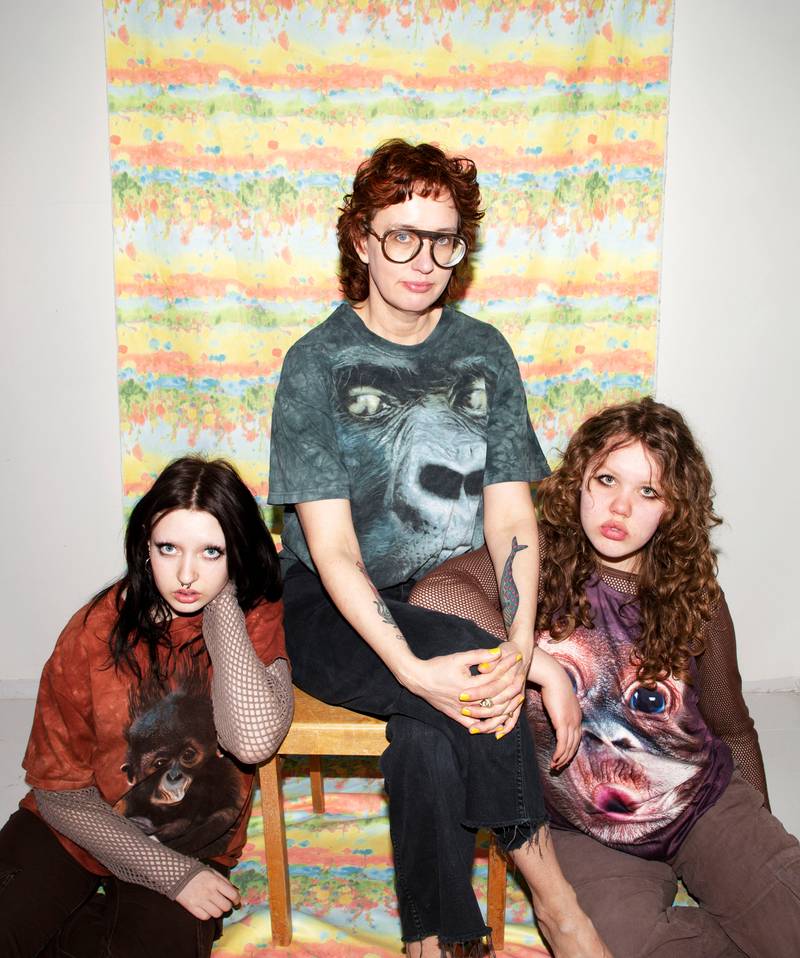

Hertta with her collaborators Irma and Elli. Image courtesy of Viivi Saikkonen.
The theme of the festival is food and the work deals with dairy production, a really big industry in Ireland. There are 800,000 unwanted male calves born in one year. A big part of them is exported very young to the Netherlands and Belgium to get slaughtered there. The size and structure of the installation come from the size of the calves’ stalls that are growing in before getting killed.
I got a kind reminder for not criticizing this issue too straightforwardly, so I am approaching the theme in a quite abstract way, trying to avoid preaching. I think who am I to tell people I don’t know or I have never talked with, what and how they should do. What would I achieve with it?
I also want people to have the possibility to see different layers in the work. Like there are beautiful pictures of trucks and galaxies and a video of kids playing in cow outfits, but the closer you look, the more you become aware of things.”
Your daughters, niece and dogs are performing in your work a lot. Do you see them as your colleagues? How would you describe your relationship with them?
At first when I started to take photos of the girls, they were more like my models. I have never pictured them in a documentary way. But they have always represented childhood, the otherness, the girliness and how time passes by in my work.
Back then I was fascinated by the materiality of photography and my process was quite slow. And when I got into KuvA, I started making videos with them and they got thrilled about that switch. Then they could move more freely and decide the movement without me stopping it. Since I would say, we have had a more collaborative way of working.
Of course, the works are mine and I determine the context and the topic, but they are quite an equal part of the working group. They create outfits, makeup and choreographies. And I love it.
In photography, I have always been thrilled that you can never completely control the outcome. There is always the possibility for surprise, either the camera or the beings who are in front of the camera make it. And the better I have become in photography, the less the medium offers surprising moments.
In photography, I have always been thrilled that you can never completely control the outcome. There is always the possibility for surprise, either the camera or the beings who are in front of the camera make it. And the better I have become in photography, the less the medium offers surprising moments.
And now we have moved on from videos to working more with live performances. Then you can never tell what’s happening next, so exciting!
I see this as a gift from them, and it is the same with the animals. It always comes out better than what one could have imagined. I see that in art it is very important to have the aspect of uncontrollability and playfulness, and in these methods and how we work currently, the play and surprises come naturally.
But in the end, I need to have the power to have control over the details, which is important to me. I would like to work in a collective, but I have accepted that I might not find it because of my willingness to have that control.
Maybe someday I will find someone, with whom I can do the whole process together. Or maybe I can develop myself to let go of more of that need of control.
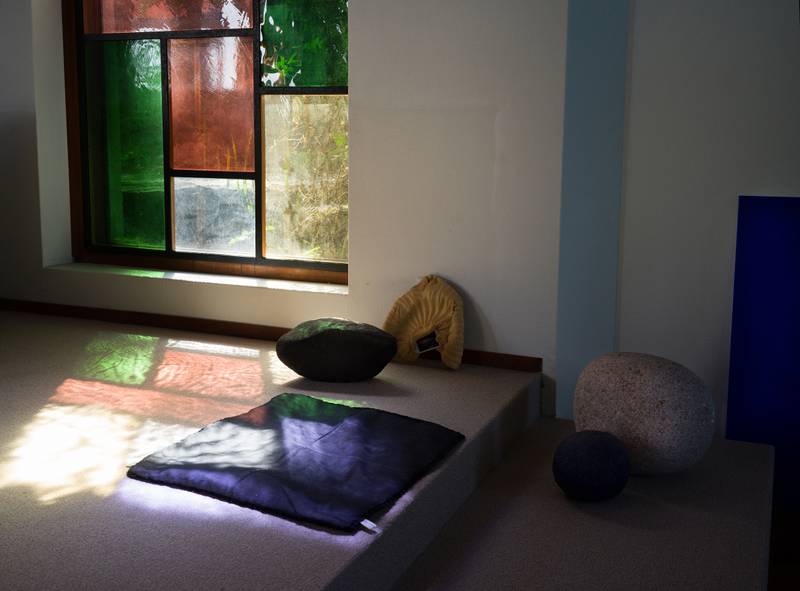

Premonition at Avantgarden, Satava, 2021. Photo courtesy of Hertta Kiiski.
How has that worked here in Avantgarden? Your works share the spaces with others and one could say they intertwine and overlap with each other a lot. In some parts, ‘it’s difficult to tell where one work begins and another ends.’
Here we have worked and spent time together, discussed a lot. We have looked after the exhibition together, and have lived with the artworks. We have been working individually but together in the same space, being physically next to each other.
It has been so interesting to see the processes of others, how the ideas develop and end up eventually. And it is so comforting to listen to others’ insecurities and doubts, or on the other hand, see the eureka moments after getting feedback from the others. It is wonderful to see how the works get born together.
In many projects I have participated in, there has been a lot of discussion about collectivity, but in reality, it doesn’t exist. In the end, people just walk in with their ready pieces. And if some discussion arises from those, it can be interesting, but not as interesting as talking about unfinished stuff. Because when you have finished something, you are already thinking about future things. As a maker, I don’t find it so sparking to talk about ready works.
I totally agree!
I kind of got in trouble when studying in KuvA for thinking that there I would have had a possibility to discuss my unfinished works. I thought it was the main reason why I am studying there.
People I’ve spoken with, who have recently graduated from there, the way of thinking and attitudes remain largely unchanged.
Yep, I got straight feedback from my fellow students that ‘How dare you show us this kind of unfinished stuff.’ I problematized and criticised my work, it is part of my process, so they were interpreting it as I wouldn’t believe in my art. Like ‘How do you even think that anyone would be interested in those if you can’t stand behind them yourself.’ And then I tried to explain that this is not finished yet, and aren’t these kinds of discussions the reason why we are here?
Later I heard that some people were talking about me in the school as a person who shows crappy unfinished work and is difficult.
That’s why I see Avantgarden as so important for me, that I can provide this kind of environment and possibility for others.
My interests are changing so often and so fast that it is impossible. And this causes big crises for me, like WHO AM I, WHAT I AM DOING?! That pressure makes you see your work like a huge unfocused and unprofessional mess.
When I am reflecting on my past studies, I have noticed that there is also quite a lot of pressure to decide what is your “style” and ways of doing and stick with it. I don’t exactly know where it comes from, maybe from society, maybe from the art tradition, from the idea of mastering something…? But at least I can’t do it! My interests are changing so often and so fast that it is impossible. And this causes big crises for me, like WHO AM I, WHAT I AM DOING?! That pressure makes you see your work like a huge unfocused and unprofessional mess.
I am like that too! I cannot focus on one narrow thing. But I think that’s also what creates the community on the field, that there are also people who are interested in many things at the same time. That’s how the networks are built.
I am mixing everything with everything in everything, it comes naturally. I try to avoid putting areas of my life in different boxes. The same is in my artworks, like in materials and themes, I make art about things that are currently in my thoughts, I use the materials I would live with at home and I use the colours I like. The visual world of my works follows what kind of socks I am wearing, and the kids and dogs with whom I share my home are making the art with me. I mainly work with people I would hang out with anyway.
So my life and art are quite much the same. That is of course also difficult because then you never have free time. On the other hand, do I need free time when my work is just life? But of course, there needs to be time to relax and just be.
I have periods in my life when I have an insane amount of things going on, and those when I have nothing. For me, the pressure is what makes things happen, but I think it is important to hibernate because it gives the thoughts the space to develop.
At least I know that I need the periods when I don’t have to think about anything art related, sometimes it can last months. But then I am panicking at the same time that everyone will forget me and I won’t have my work anymore after.
I was thinking after finishing Primeval Soup that what if this is my last exhibition and I will not be asked to exhibit anywhere ever again. That this might be it. And it is the same with every exhibition.
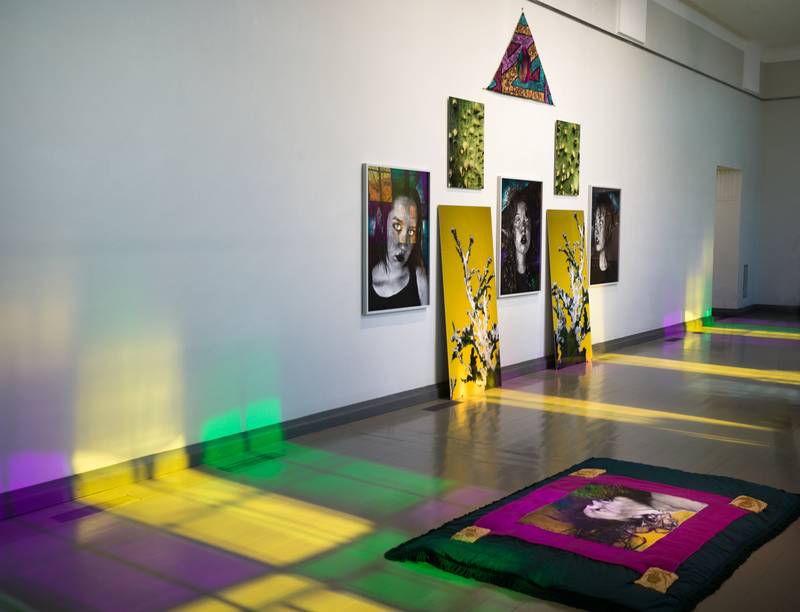

Altar at Primeval Soup, Turku Art Museum, 2021. Photo courtesy of Hertta Kiiski.


The singing burl presiding over the meeting at Primeval Soup, Turku Art Museum, 2021. Photo courtesy of Hertta Kiiski.
I think that is both horrible and comforting to hear, that a person who is well established is suffering from the same fears as me - an artworld hatchling. That this horror is stable. It makes me feel that we are in this same shit together. It relieves you from the pressure of constantly achieving something better and bigger, then you can just focus on doing, it helps to accept that this is the reality.
All this uncertainty and precarious circumstances are always there. I have been in the committees reading the grant applications and there I have noticed that the reality is that every time you have to start from the beginning. You have to explain your target groups and yourself. It is a fair deal of course, but at the same time it is quite heartbreaking that you have been committed to your work for 50 years, people know you and still, you start from zero and are applying your salary. You need a lot of motivation to do it. And what I have learned over the times is that it is a lot about luck whether you get funding or not. I know so many people who work so much, but there just isn’t the money for everyone.
It is quite heartbreaking that you have been committed to your work for 50 years, people know you and still, you start from zero and are applying your salary. You need a lot of motivation to do it. And what I have learned over the times is that it is a lot about luck whether you get funding or not.
It would be so nice to change that structure, but the task feels so complicated and big, it makes you feel powerless. And then you just accept reality, conform with it. And of course, the reality is easy to accept as a Finnish white, able-bodied artist working in this field, I have quite good premises to survive.
Exactly! I have tried to be active in different associations, like in Arte ry which runs Titanik gallery, and tried to work there towards changing the structures. I am talking about things like paying the artist fees and offering the gallery space for free, working for gender equality and diversity, and of course, I try to talk about these things in public when I get the platform… I know these are quite small things, but I feel creating and setting the new standards even from the local level is important. For example, it has given me hope to see how the amount of free gallery spaces has increased, even if it is happening slowly.
And when I am teaching, I also try to encourage my students not to be too humble, I try to give them the confidence to think they have the full right to exist as an artist and get paid for it, that being an artist doesn’t mean you are an outsider or some kind of a parasite.
So nicely put! I can totally relate to those thoughts. I just got a grant, and when I realised I can’t pay taxes from that, I got pissed off. That once I get the chance to prove that I am “a proper part of the society”, I get denied from being that.
And sometimes I look at what I do so critically, that I don’t see all the tiny things that I have done and achieved. But the things you just mentioned are topics that are discussed daily in the communities where I work; they have become the new norm there. Thank you for reminding me!


First Snake, 2021. Photo courtesy of Hertta Kiiski.
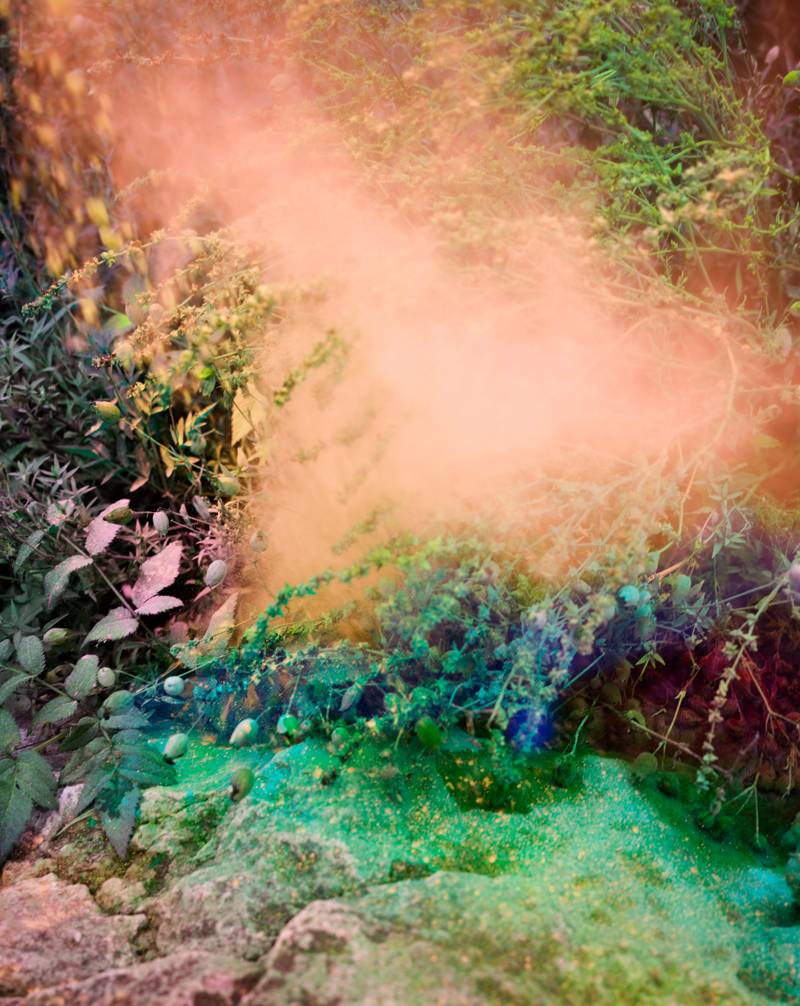

Smoke, 2021. Photo courtesy of Hertta Kiiski.
The third cup of coffee starts to hit and Hertta’s tasks in the exhibition are calling, we are trying to wrap things up.
This has been a fruitful and warm discussion, thank you! Would you still want to add something?
Hmmm… I always start regretting after talks and interviews, what I should have said. I love to listen to other people’s artist talks admiring how they can speak so clearly only about their work. I often blame myself for not presenting myself as a credible art professional and sticking with one topic.
I have had the same “problem” forever. When I was working in a bookstore, I had my pockets full of customer’s wishes and reading tips for them. I just tend to take people’s needs and worries to carry. But then I comfort myself that I am just like that.
Well, first of all, it is weird that you say that you don’t have credibility. I think credibility does not grow only in the ability to answer solely the questions you are asked or presenting yourself as a so-called expert… I find being genuine and kind is credible.
The image of a person with expertise and credibility is one-sided in our culture, and I would love to embrace more the fact that the expertise can also be that you know a little about lots of different topics and build connections between them, like mycelium.
Yep, it is so much easier to show in-depth knowledge on some narrow topic than a wider silent knowledge that has been built over time. Ki Nurmenniemi and Anna-Kaisa Koski told me nicely when I was worrying that one of my artworks was left a bit unfinished here in Avantgarden because I was just cooking soup and talking with people, that the care is often shown only to people who are the objects of it.
It is not always visible even to them, because the care work is considered so obvious! Often you are not even seeing it yourself.
I would like to see the ability to do the care work as my expertise and embrace it as a significant part of my practice. If I could just recognise it better, I could be more pleased about it.
I have seen it as an artist how important it is to take care of the other artists. For example, when I was participating in the Parantola exhibition in Paimio Sanatorium, and I went to install the work, there was a vegetarian wrap reserved for me. I was so touched, like ‘IS THIS FOR ME?’ Often the artists are used to being grateful for so little things that even these kinds of tiny gestures make your eyes water. From these kinds of experiences I have learned to include care work more to my work too.”
It is kind of sad to hear you say that offering a snack for an artist is an exception, that you were not used to that people who work on the same project together can take care of each other.
Once when I expressed my need for care and kindness during a process, I was just told that ‘This is the art world, what are you whining?’ Ok, it was a personal discussion, not with any institution or so, but still. The attitudes are sticking tightly.
I have one experience too when we were having an exhibition in one well-known gallery in Helsinki. First of all, I was having a bad conscience that we paid so much rent, and when we went there for the first time, we were told that “Don’t touch these tea bags, they are the property of the gallery.” And I was so astonished. We didn’t receive any help from the gallery personnel, nor the teabags. This shows so well what is the position of an artist in some places, which are the spaces where artists are supposed to be supported.
That’s why I think it is wonderful to see the new generations changing that culture. It gives me hope.
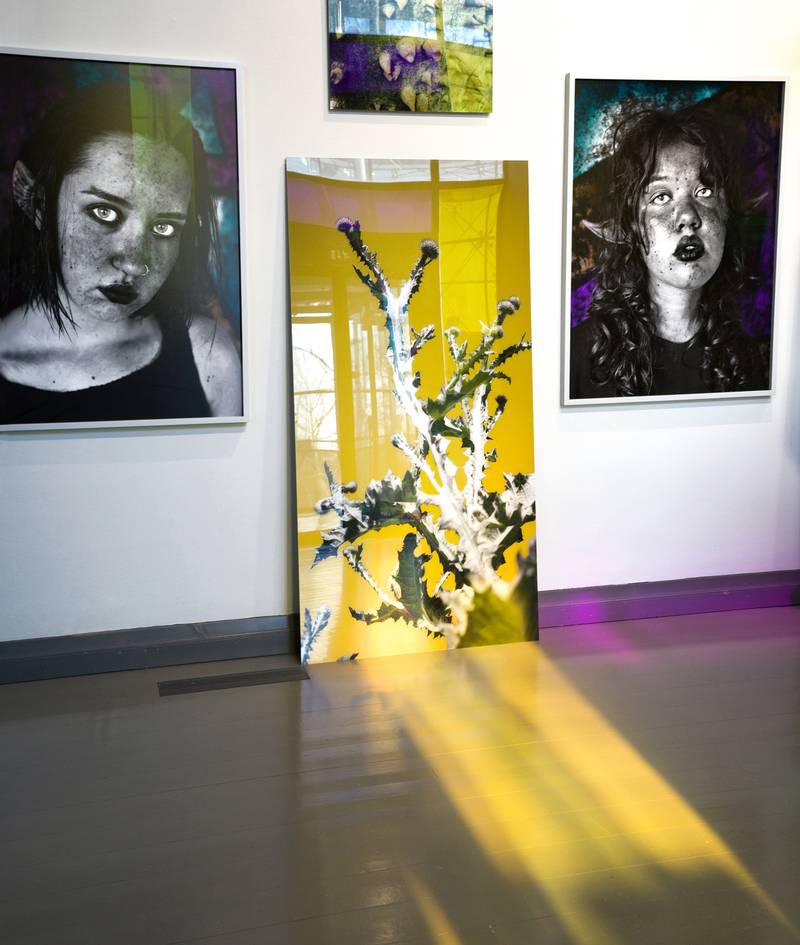

A detail of Primal Soup, Turku Art Museum, 2021. Photo courtesy of Hertta Kiiski.
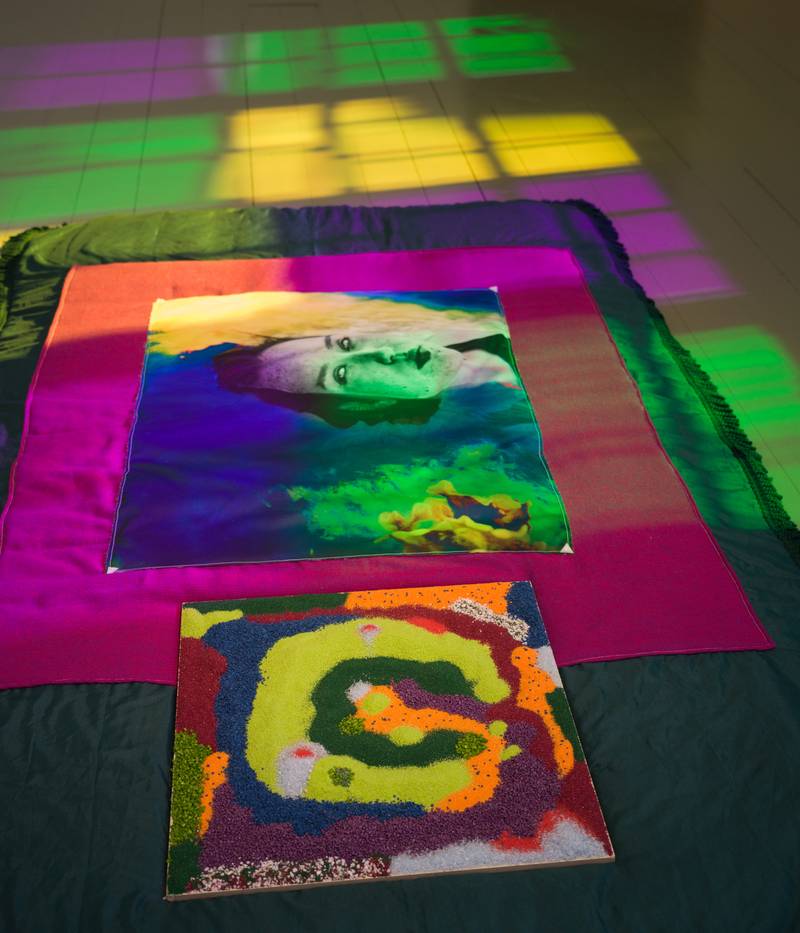

A detail of Primal Soup, Turku Art Museum, 2021. Photo courtesy of Hertta Kiiski.
After flapping our arms vigorously in the air for hugging gestures, I see Hertta hurrying to host the exhibition guests and cooking more coffee, doing her work and living her life.
